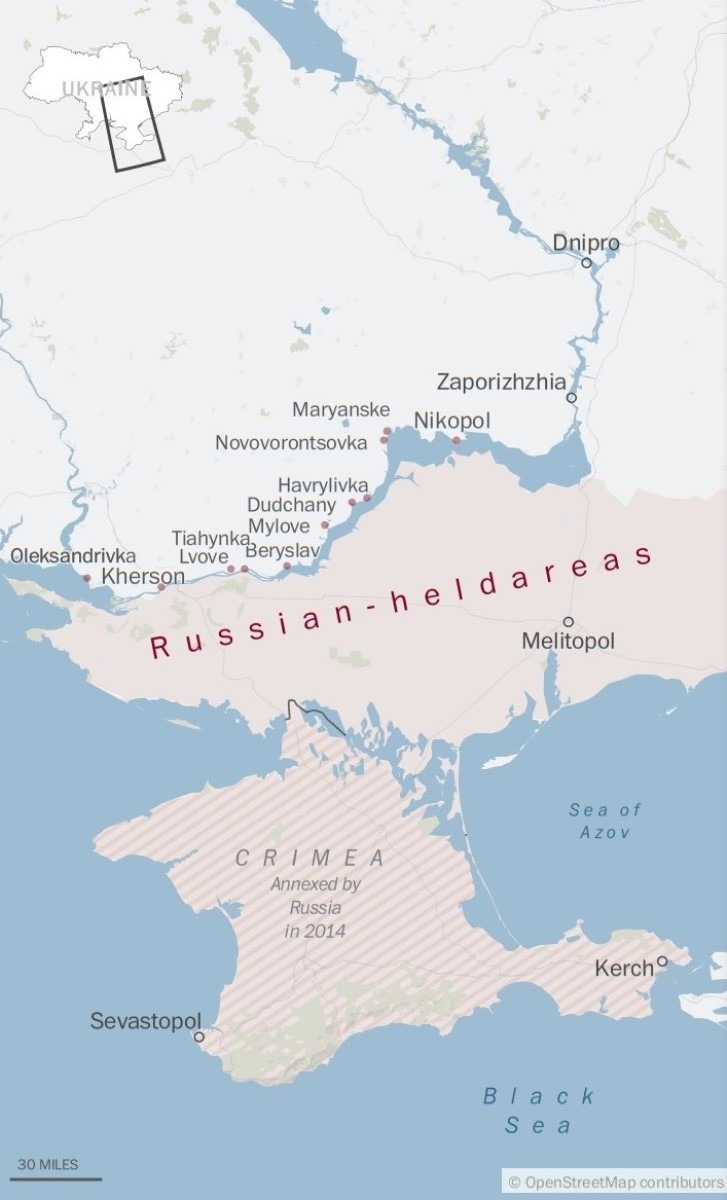
15:35 JST, January 31, 2023
ALONG THE SOUTHERN DNIEPER RIVER, Ukraine – Only the water keeps them apart.
Russian soldiers – pushed into retreat by a counteroffensive late last year – control the east bank of the mighty Dnieper River. Ukrainians control the west.
As Ukraine awaits new tanks from the United States and Europe, and fighting rages over strategic towns in the east, a war of attrition is underway in this southern battleground. The river limits territorial advances, permitting – for now at least – only destruction from a distance.
On the route traveling east and north from villages on the Gulf of the Dnieper to the battered but never-occupied city of Nikopol, the width of the river ranges from several miles to fewer than 1,000 feet, putting the Russians close enough to strike with mortars and shells or sniper fire. They hit some villages dozens of times a day. Ukrainian forces are firing back.
Before the war, the journey would have amounted to about 150 miles – and taken a few hours to drive. But with damaged roads and bridges over the river’s inlets, the journey through former Russian occupied territory has become difficult. Roads are still littered with abandoned Russian checkpoints and military equipment. Russian trenches and firing positions are dug into farmers’ fields. Signs warn of mines. At village entrances, Ukrainian troops warn the chances of being shelled are high.
Washington Post journalists spent several days traveling along the Ukrainian-controlled main and back roads that connect these towns and villages to see how civilians are surviving winter, frequently without gas or electricity. Often only the elderly are left, surviving without heat on food handouts. Residents fear they could be killed at any moment, and still whisper of collaborators living among them.
Many of the villages here withstood months of Russian occupation, and are in territory President Vladimir Putin claims, illegally, to have annexed. The Kremlin now insists they must be “liberated” – signaling Moscow’s resolve to return, possibly in new offensives this spring.
Oleksandrivka
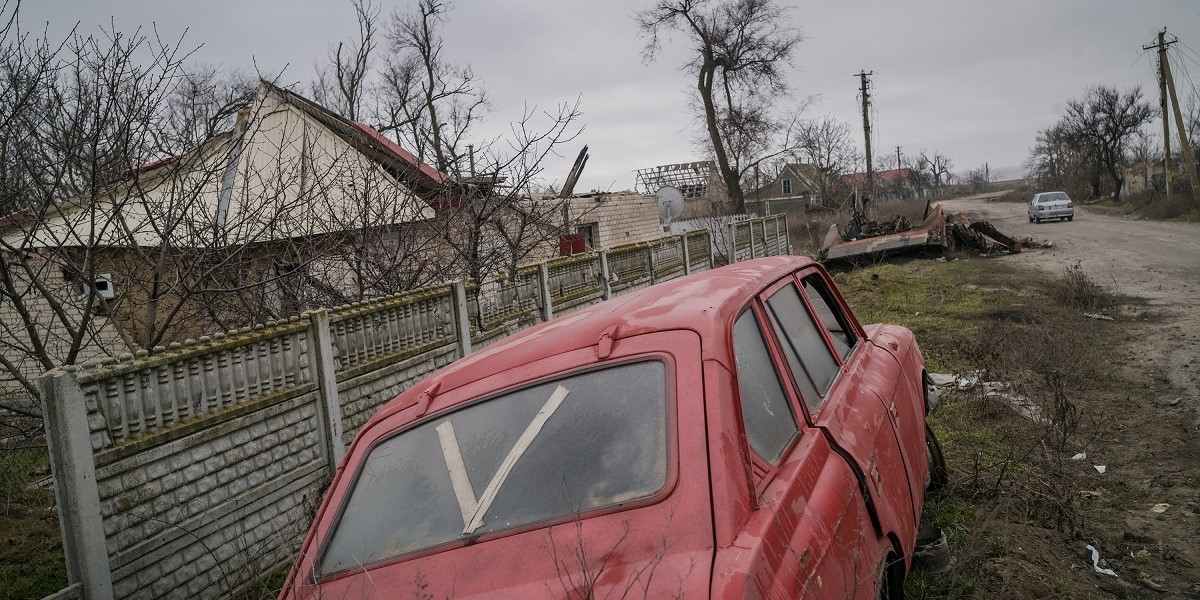
Destruction in the village of Oleksandrivka, Ukraine, on Jan. 21. Only 16 of the village’s roughly 2,000 residents remained during months of Russian occupation. Others are now starting to return.
The damaged road into this recently liberated village is a harbinger for what lies beyond. Burned-out cars and carcasses of a cow and dog are scattered on the side of the road. Soldiers shouted frantically to stay on hard ground – the marsh below still hasn’t been demined.
Before the war, 2,123 people lived in this peaceful enclave on the Gulf of the Dnieper. But fighting grew so fierce here that by last spring, only 16 residents remained. Russian forces controlling the town evacuated most others to villages deeper inside Russian-occupied territory.
Once Ukraine retook the village late last year, civilians started to return and assess the damage. But most found there’s little left. More than two months after liberation, only 150 people now live in the wreckage.
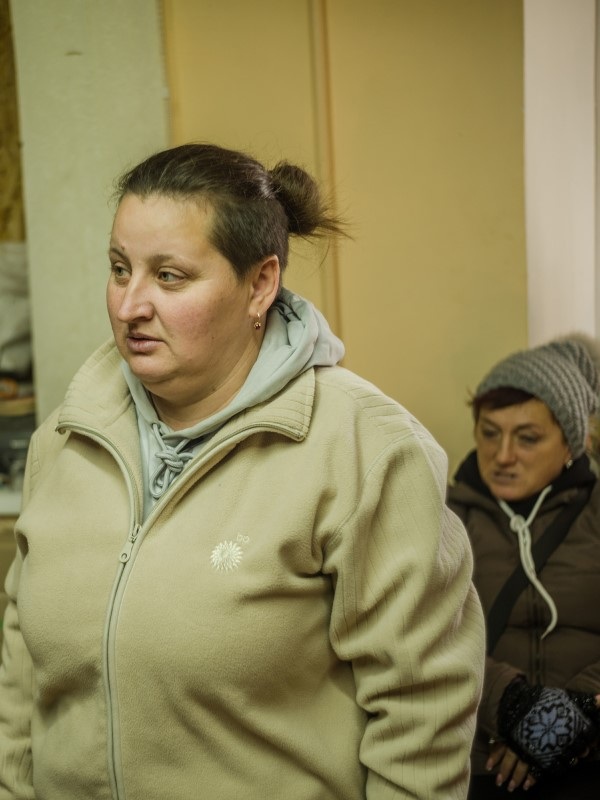
Natalya Kamenetska, 36, at a community center in Oleksandrivka.
“If there was a hell, it was here,” said village leader Natalya Kamenetska, 36. Some residents were executed. Four are still missing. Exhumations are still underway, but the village remains so heavily mined that the process is slow.
Residents who need repairs to their homes must visit Kamenetska’s office at the village council to fill out questionnaires and register for aid. Many are impatient.
In a damaged kindergarten nearby, Yaroslava Kusherenko, 81, was trying to drag a large, dirty rug out of a brightly painted classroom. Kusherenko spent seven months in the nearby village of Bilozerka after Russian forces moved her there during heavy fighting. “I spent the first three months crying,” she said.
When she returned home after liberation, all that remained of her house was her kitchen. Her cows had been slaughtered and she and her son now live off humanitarian aid. Her stove still works, which has saved them from freezing. But she needed the carpet, she said, to warm up her makeshift bed.
She worried she would be punished for taking it, even though it wasn’t being used. But she was so cold, she said, she did not know what else to do.
“We had such a beautiful village. People were so happy. There was so much green. And see what has happened to it now,” she said, gesturing to the bombed-out kindergarten behind her. “In one second, I lost everything. Who will return it to me?”
Tiahynka
In the three months since Ukrainian forces liberated Tiahynka, Helena Horobets, 72, has prepared carefully for the possibility that daily Russian shelling from across the river might destroy her home.
She and her son wrapped their valuables in plastic – including the dress she wants to wear to her own funeral, should she be killed – and moved themselves and their belongings to their cramped basement where they now spend most of their time.
With no power, Horobets’s connection to the outside world has been limited to using a neighbor’s generator to occasionally watch TV. But news of what is happening elsewhere in Ukraine, she said through tears, just “makes me sad.”
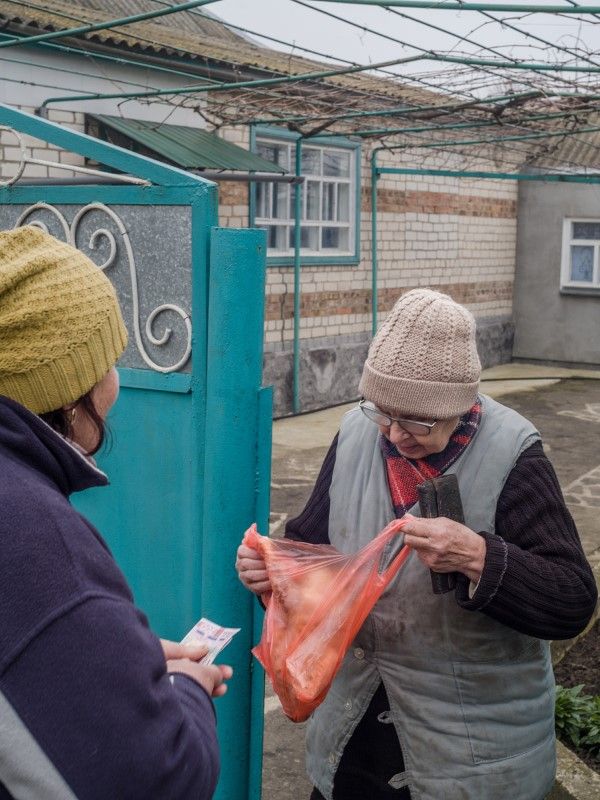
Yaroslava Kusherenko, 81, carries a carpet from a kindergarten in Oleksandrivka to use in her home, which has no heat.
On a recent morning, she came upstairs, opened her blue gate and handed her neighbor a small wad of cash. In return, Alla Kravtsova, 55, passed a raw chicken in a red plastic bag. It would sustain Horobets for about a week.
At her home down the street, Kravtsova’s chickens, geese and turkeys squawked as she opened her barn door, revealing four cows. The youngest, Borka, is only two weeks old.
Selling poultry and dairy has helped Kravtsova survive. But her responsibility to the animals, she said, has also trapped her here. Just before Ukraine retook her village, Kravtsova’s daughter and granddaughter fled. The 5-year-old was so traumatized by the war that she developed a stutter and shaky hands.
They are now safe in Lithuania while Kravtsova sleeps most nights in her cellar where she stores jars of preserves made during occupation. “My daughter asked me to forgive her for leaving me alone,” she said. “I told her ‘Save the child.'”
She stepped down a rickety ladder to her basement to rummage through her supply and emerged weeping – the dusty jars filled with pickled red peppers, strawberries and squash a reminder of the darkest days of Russian control. “I was afraid my children and grandchildren would die of hunger,” she said.
In her kitchen, Kravtsova flicked on a small lamp powered by a car battery and recounted how she thought Ukraine’s advances meant her family would be able to return. But the Russians barely retreated. “We were waiting for autumn to put an end to it,” she said. “Now we’re waiting for spring.”
Lvove
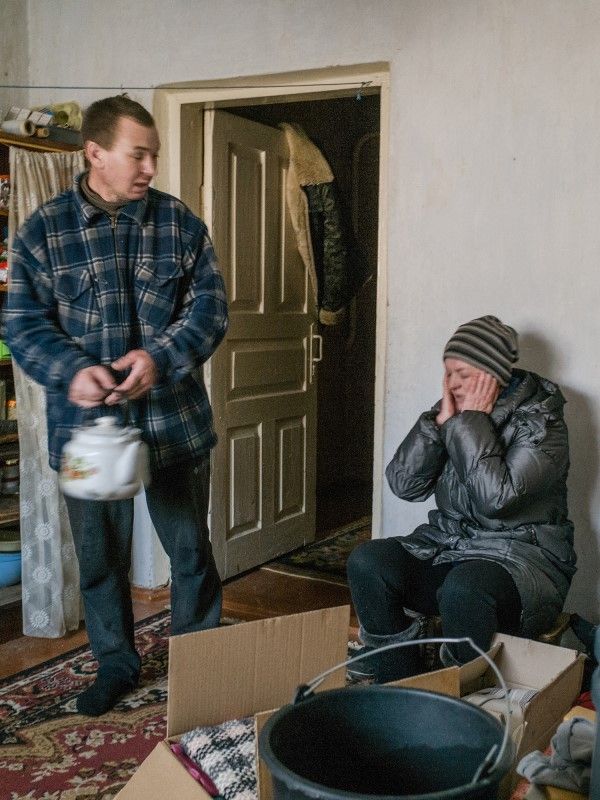
Natasha, 39, and Anton Dyadchenko, 41, in their house in Lvove.
Soon after Ukrainian forces pushed Russians out of this village in November, Natasha and Anton Dyadchenko adopted new rules: 1. Avoid leaving home at all costs 2. If you must go outside, run as fast as you can. 3. Always stay between houses for cover.
They had watched with fear that month as the retreating Russians set up a pontoon bridge and crossed from their riverbank to the other side. The next day, their three children, ages 9, 13 and 14, were playing outside when Ukrainian troops arrived.
Civilians fell to their knees in thanks. A giant Ukrainian flag was spread across the main street.
But within days, Russian attacks from across the river began. People fled. “The shelling started to get loud and the kids were very scared,” Natasha said, so they made the decision to send them to their grandmother’s house in central Ukraine.
Now their street is quiet, save for barking dogs whose families fled. On their limited ventures outside, the Dyadchenkos see few people. They have not left because Natasha’s elderly mother wants to stay.
For now, they are surviving off the animals they raised, including her mother’s seven cows, 10 chickens and 20 ducks. The livestock helped keep them afloat during occupation. Each week, they braved the road to sell meat in the market in Kherson.
But their supplies won’t last forever. When asked how many pigs were left, Natasha gestured at the one they had slaughtered that morning, which they would butcher in their kitchen. “None now,” she replied.
Mylove

A repaired bridge near the village of Mylove.
After a few hours without explosions, a handful of civilians here felt safe enough to step outside for some fresh air. The last blast had been that morning. Now it was afternoon.
“Thank God today has been quiet so far,” said Yuriy Boronko, 69, as he walked by pushing his bike. It was a day off for the humanitarian aid station where residents usually collect food.
A young couple walked by with their dog. They are surviving, they said, on bread and beans. There has been no electricity, gas or water since the retreating Russians bombed the infrastructure. Continuous shelling has made repairs impossible.
“The ‘liberators’ on the other side of the river are shelling us,” said Valeriy Kulyush, 57. “We just have to persevere.”
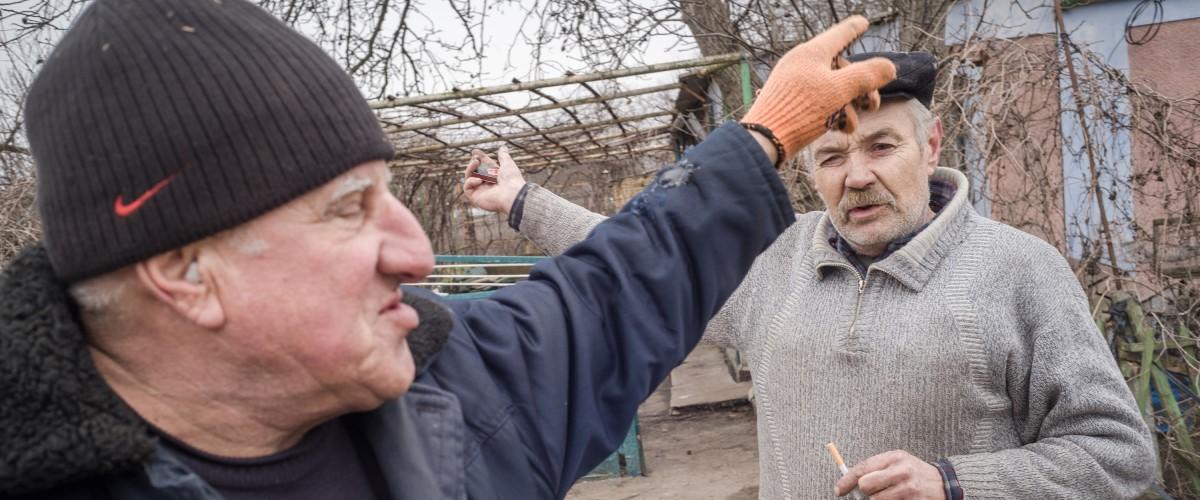
Yuriy Boronko, 69, left, and Valeriy Kulysh, 57, walk in Mylove.
Dudchany/Havrylivka
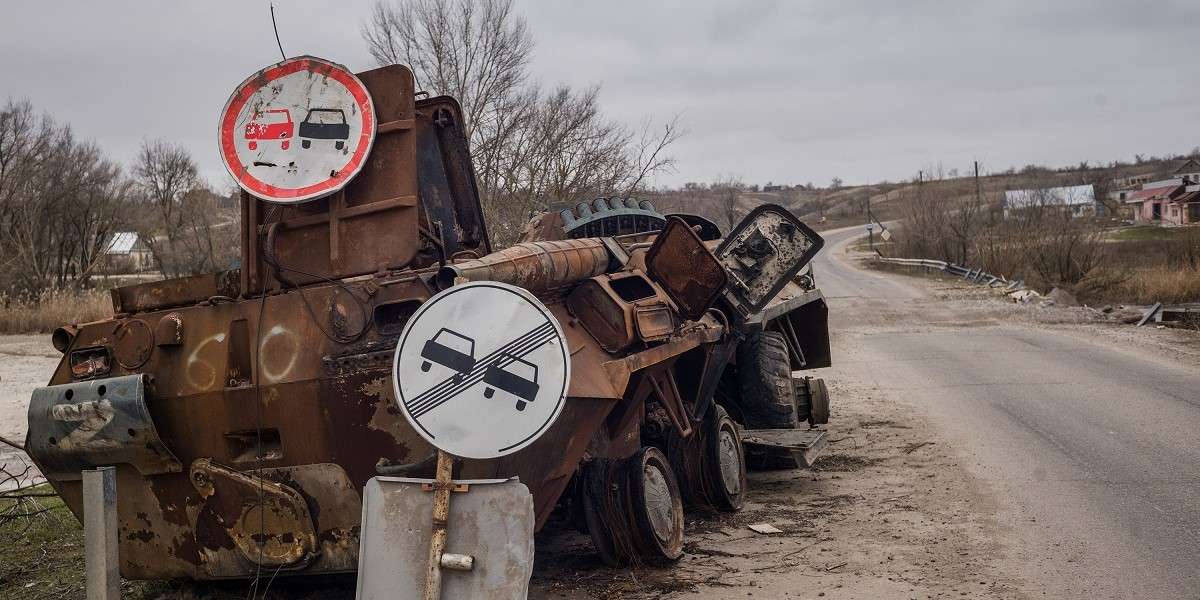
A destroyed Russian armored personnel carrier in Dudchany.
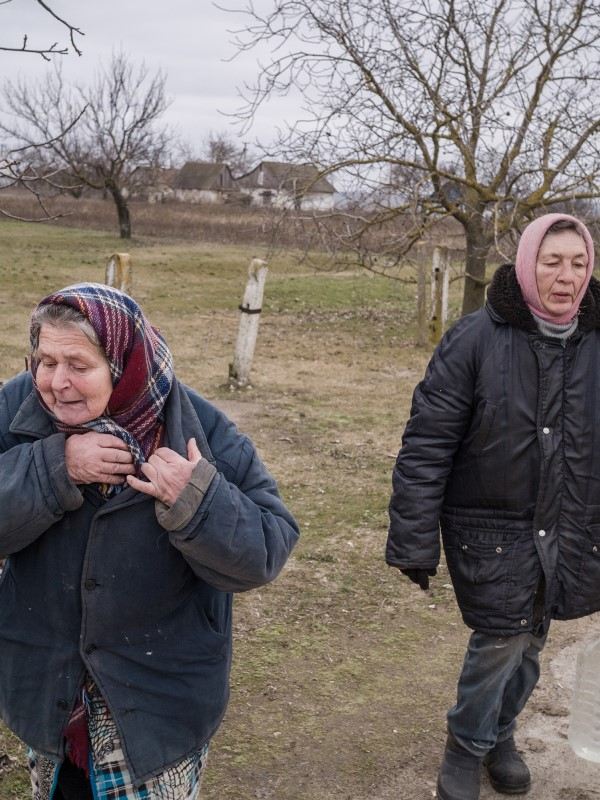
Lyuba Voznyak, 66, left, and Olha Perepada, 54, are among the few residents of Dudchany who decided to stay in the village.
This village has been shelled so much lately that Lyuba Voznyak, 66, no longer knows where to hide. On a recent afternoon, she sat outside her red gate riddled with bullet holes, shivering on a rickety bench. Her street was deserted.
“I’m afraid to sit in my house because I’m afraid it will collapse on me,” she said. But “it’s even too scary to sit in my garden. How do you expect me not to shake?” The only ones left, she said, are “pensioners with nowhere to go.”
Just two days earlier, a house around the corner was hit by a Russian strike from across the river. The people had already left, Voznyak said, but their animals – including dogs and chickens – were still outside.
Voznyak’s children have begged her to evacuate. But after surviving occupation, she doesn’t want to flee. “I need to watch over my garden,” she said.
Then, another boom, as a mortar landed nearby.
The strike Voznyak and Perepada heard from Dudchany hit a garage housing farm machines down the road in the village of Havrylivka. No one was killed or wounded. A fire blazed in the yard. Plumes of smoke rose into the sky. A dog walked by. A group of men, accustomed to shelling, stood outside joking about the strike just minutes after the blast. None of them, they said, had anywhere else to go.
Novovorontsovka/Maryanske
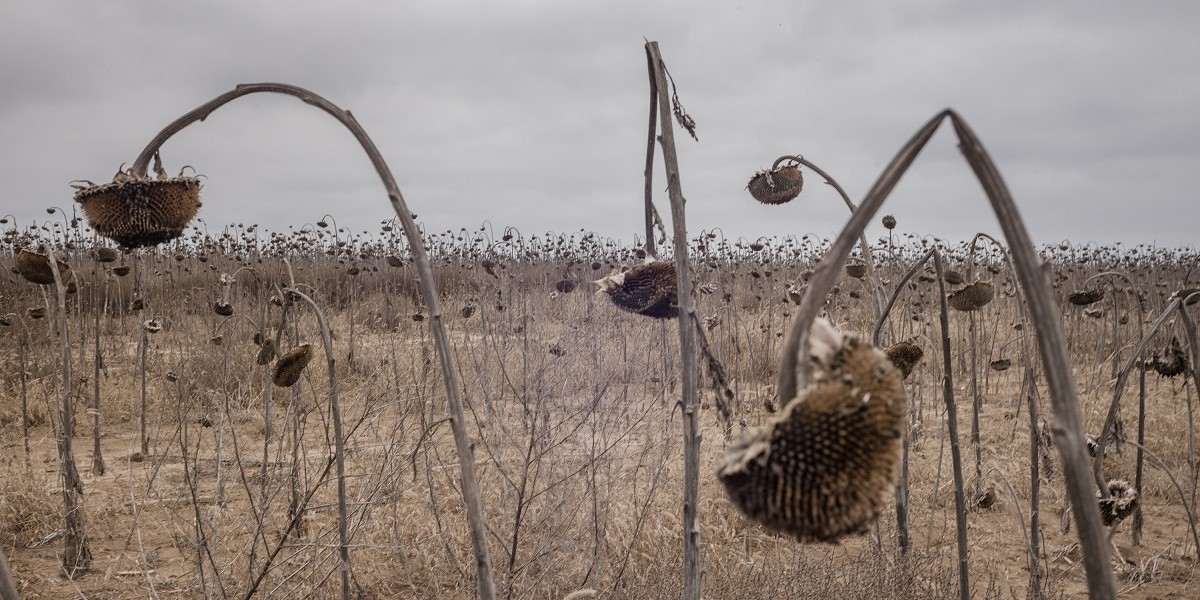
A field of dead sunflowers on the road to Novovorontsovka.
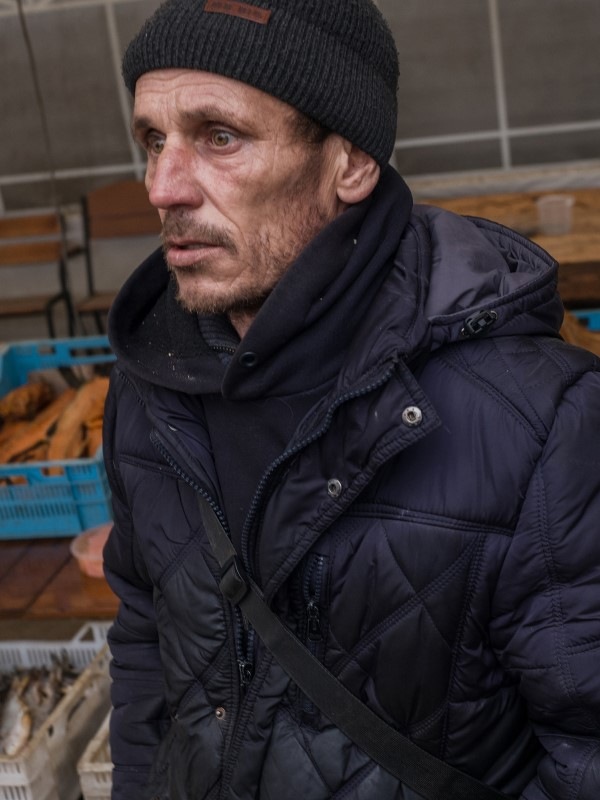
Viacheslav Borysenko stands near his fish stall in Maryanske.
On a recent day, volunteers from nearby Zolota Balka came to Novovorontsovka to pick up supplies, including bread. Their village had been hit 60 times the day before, they said.
Novovorontsovka hasn’t been shelled as regularly and has become a haven for storing humanitarian aid. Locals are starting to replace their broken windows, with glass purchased through a grant from the European Union.
Another four miles north, in riverside Maryanske, Viacheslav Borysenko has sold fish at a market for 22 years. Now, with much of this stretch of river too dangerous for boats, the fish he sells come from upstream. To live on the river and import fish “feels weird, but what can we do?” he said. “We have to adapt.”
Nikopol
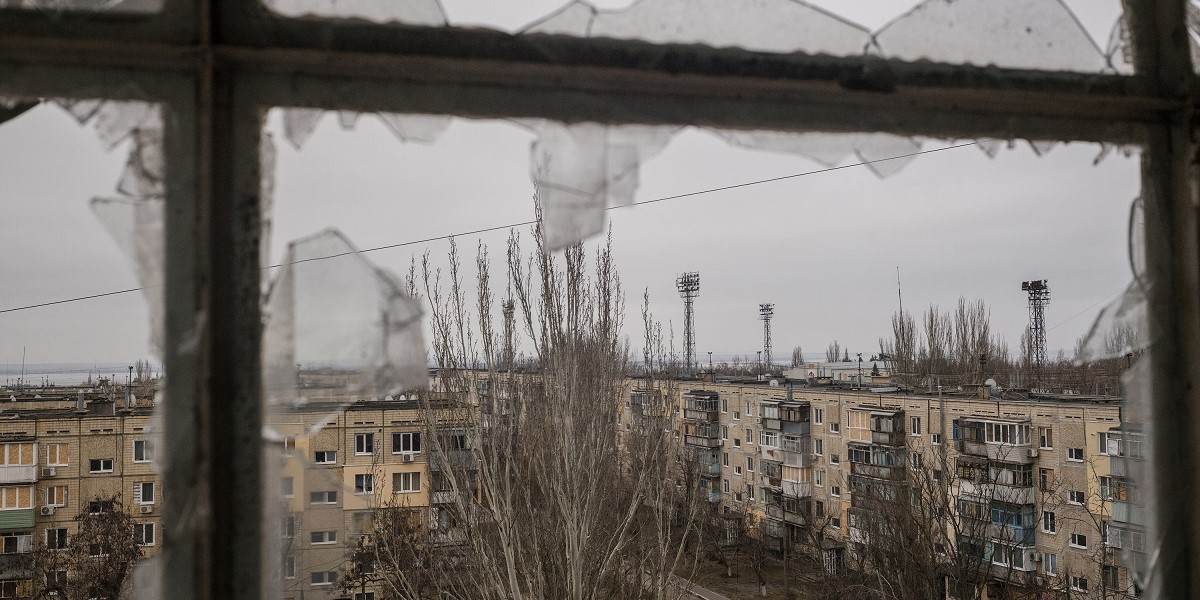
Nikopol seen from Lyudmila Kruhlenko’s shelled apartment.

Despite the damage, Kruhlenko refuses to leave Nikopol.
Lyudmila Kruhlenko, 53, had just set out snacks on New Year’s Eve when a blast hit her building, badly damaging her balcony and destroying part of a neighbor’s apartment. Still, she did not consider leaving.
“The mood is to stay until victory,” Kruhlenko said. “The people left here are very strong.”
Mayor Oleksandr Sayuk, 49, said more than half the city’s 106,000 people have fled – including his wife and children. The city, perched on a wide section of the river, is protected by the water. Russian forces “don’t have the possibility to easily get to the city,” Sayuk said. “The negative side,” he added, is the Russians are still within range. “They shell whenever they please.”
"News Services" POPULAR ARTICLE
-

American Playwright Jeremy O. Harris Arrested in Japan on Alleged Drug Smuggling
-

Japan’s Nikkei Stock Average as JGB Yields, Yen Rise on Rate-Hike Bets
-

Japan’s Nikkei Stock Average Licks Wounds after Selloff Sparked by BOJ Hike Bets (UPDATE 1)
-

Japanese Bond Yields Zoom, Stocks Slide as Rate Hike Looms
-

Japan’s Nikkei Stock Average Buoyed by Stable Yen; SoftBank’s Slide Caps Gains (UPDATE 1)
JN ACCESS RANKING
-

Keidanren Chairman Yoshinobu Tsutsui Visits Kashiwazaki-Kariwa Nuclear Power Plant; Inspects New Emergency Safety System
-

Imports of Rare Earths from China Facing Delays, May Be Caused by Deterioration of Japan-China Relations
-

University of Tokyo Professor Discusses Japanese Economic Security in Interview Ahead of Forum
-

Japan Pulls out of Vietnam Nuclear Project, Complicating Hanoi’s Power Plans
-

Govt Aims to Expand NISA Program Lineup, Abolish Age Restriction

























